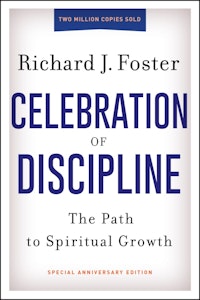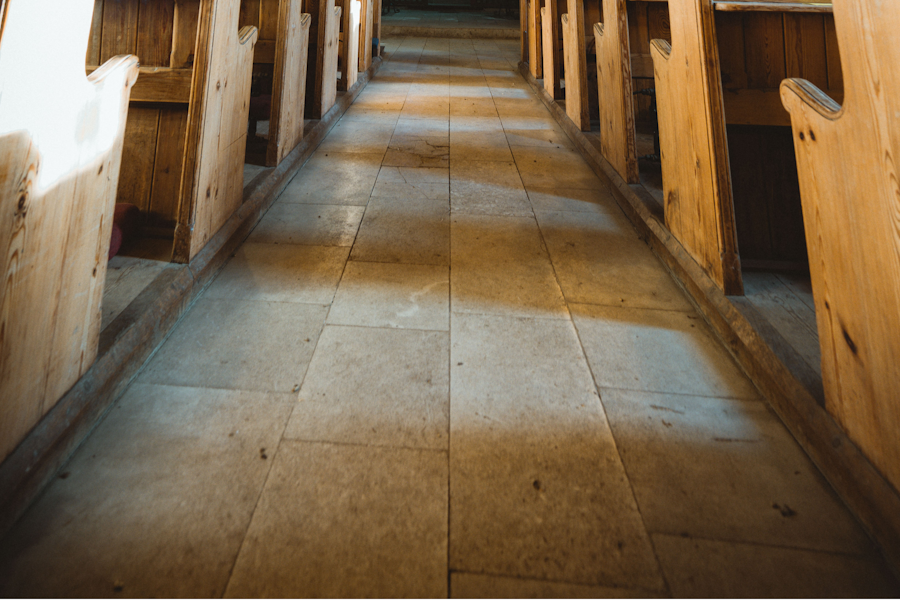Introductory Note:
In the 20th Anniversary Edition of Celebration of Discipline, Richard Foster honors God’s provision of “three converging influences” that deepened his faith and grew his appreciation for the crucial role of disciplines in spiritual growth. The following excerpt tells the story of three particular sources—from diverse branches of the Christian family—that had a deep, formational impact on Richard’s life with God.
Renovaré Team
 Excerpt from Celebration of Discipline
Excerpt from Celebration of Discipline
It is a wonder to me how God uses squiggles on paper to do his work in the hearts and minds of people. How are these squiggles transformed into letters and words and sentences, and finally, meaning? Oh, we may congratulate ourselves on knowing a little about the function of neurotransmitters in the brain or about how endorphin proteins affect learning and memory retention, but if we are honest, we know that thinking itself is a mystery. Doxology is the only appropriate response.
At this writing, it has been two decades since the particular set of squiggles titled Celebration of Discipline was first published. After the first decade the publisher, no doubt puzzled by its longevity and popularity, wanted to celebrate this milestone, and asked me to revise the original text — which I was glad to do. And now, after a second decade, the puzzle continues. Somehow (who can ever explain how?) people continue to find help in their daily walk with God through the pages of this book.
To celebrate this twentieth anniversary the publisher has asked me to write an introduction, and, again, I am glad to comply. And perhaps in fulfilling their request it is appropriate to tell how the book, Celebration of Discipline, came into being.
Spiritual Bankruptcy
Fresh out of seminary, I was ready to conquer the world. My first appointment was a small church in a thriving region of Southern California. “Here,” I mused, “is my chance to show the denominational leadership, nay, the whole world what I can do.” Believe me, visions of far more than sugar plums were dancing in my head. I was sobered a bit when the former pastor, upon learning of my appointment, put his arm on my shoulder and said, “Well, Foster, it’s your turn to be in the desert!” But the “sobering” lasted only a moment. “This church will become a shining light set on a hill. The people will literally flood in.” This I thought, and this I believed.
After three months or so I had given that tiny congregation everything I knew, and then some, and it had done them no good. I had nothing left to give. I was spiritually bankrupt and I knew it. So much for a “shining light on a hill.”
My problem was more than having something to say from Sunday to Sunday. My problem was that what I did say had no power to help people. I had no substance, no depth. The people were starving for a word from God, and I had nothing to give them. Nothing.
Three Converging Influences
In the wisdom of God, however, three influences were converging in that little church that would change the direction of my ministry, indeed, of my whole life. Together they would provide the depth and the substance I needed personally and the depth and the substance that, in time, would lead to the penning of Celebration. But that is running ahead of my story.
The first thing to happen was precipitated by an influx of genuinely needy people into our small congregation. They simply flowed in like streams after a thunderstorm. Oh, how they hungered for spiritual substance and, oh, how willing they were to do almost anything to find it. Now, these were the castoffs of today’s fast-track culture — ”the sat upon, spat upon, ratted on” — and so their neediness was quite obvious. Just as obvious was my inability to give them substantive pastoral care.
This lack of any real spiritual density led me, almost instinctively, to the Devotional Masters of the Christian faith — Augustine of Hippo and Francis of Assisi and Julian of Norwich and so many others. Somehow I sensed that these ancient writers lived and breathed the spiritual substance these new friends in our little fellowship were seeking so desperately.
To be sure, I had encountered many of these writers in academic settings, but that was a detached, cerebral kind of reading. Now, I read with different eyes, for daily I was working with heart-breaking, soul-crushing, gut-wrenching human need. These “saints,” as we sometimes call them, knew God in a way that I clearly did not. They experienced Jesus as the defining reality of their lives. They possessed a flaming vision of God that blinded them to all competing loyalties. They experienced life built on the Rock.
It hardly mattered who I read in those days — Brother Lawrence’s The Practice of the Presence of God, Teresa of Avila’s Interior Castle, John Woolman’s Journal, A. W. Tozer’s The Knowledge of the Holy—they knew God in ways far beyond anything I had ever experienced. Or even wanted to experience! But as I continued to soak in the stories of these women and men who were aflame with the fire of divine love, I began desiring this kind of life for myself. And desiring led to seeking and seeking led to finding. And what I found settled me, deepened me, thickened me.
The second influence came from an individual in that tiny congregation, Dr. Dallas Willard. A philosopher by profession, Dallas was well versed in the classics, and, at the same time, had an uncanny perception into the contemporary scene. He taught our fledgling little group: studies in Romans and Acts and the Sermon on the Mount and the Spiritual Disciplines and more. But regardless of the specific topic he constantly drew us into the big picture. It was life-based teaching which always respected the classical sources and always sought to give them contemporary expression. Those teachings gave sources and always sought to give them contemporary expression. Those teachings gave me the Weltanschauung, the worldview, upon which I could synthesize all my academic and biblical training.
But it wasn’t just the teaching, or at least it wasn’t teaching as we usually think of teaching. It was a heart-to-heart communication that went on between this world-class philosopher and that little ragtag band of Christ’s disciples. Dallas taught us right in the midst of our struggles, our hurts, our fears. He had descended with the mind into the heart and taught out of that deep center.
Today, many years later, I still revel in the impact of those teaching/living/praying sessions. It was, of course, teaching-in-community. We were in each other’s homes; laughing together, weeping together, learning together, praying together. Some of the best teaching times grew out of the dynamic of those home settings where we might go late into the night — posing questions, debating issues, applying gospel truth to life’s circumstances. Dallas would move among us, teaching, always teaching. A spiritual charism of teaching, I think. Teaching with wisdom. Teaching with passion. Teaching with heart. And always we experienced a sense of the numinous.
The third influence came initially from a Lutheran pastor, William Luther Vaswig. (With a name like “William Luther Vaswig” how could he pastor anything but a Lutheran church?) Bill’s church, large and influential, overshadowed our tiny Quaker fellowship. But what drew me to Bill had nothing to do with “large” or “influential” or even “Lutheran.” No, what I saw was someone thirsting for the things of God. So I sought him out. “Bill,” I said, “you know more about prayer than I do. Would you teach me everything you know?”
Now, the way Bill taught me about prayer was by praying. Lively, honest, heartfelt, soul-searching, hilarious praying. As we did this, over time we began experiencing that “sweet sinking into Deity” Madame Guyon speaks of. It, very honestly, had much the same “feel” and “smell” as the experiences I had been reading about in the Devotional Masters. This movement into prayer was actually a two-pronged influence. My praying experiences with Bill were augmented by those of a wonderfully determined woman, Beth Shapiro, who was the head of the elders for our little fellowship. Beth was a nurse at a large hospital, and after working the night shift, she would come over to our small church building in the early morning and we, Beth and I would spend an hour or two, praying for people. All kinds of people. People in our fellowship and people outside our fellowship. Whomever and whomever, Beth would want to pray for them.
Then we would often discuss issues of theology, of faith, of life. And whatever we talked about Beth tested out at the hospital. If we discussed the Bible’s teaching on “the laying on of hands,” at work Beth would put her hands through the holes of an incubator and place them on a premature infant, praying silently and lovingly, and watch that little one increase in health and well-being. These were the kinds of things Beth would do, not just now and again, but repeatedly. Through Beth I learned the necessity of bringing spiritual realities into the press of raw humanity.
Now, these three influences converged in those days of my young pastoring, and the result was a quiet revolution, inside and out. And in our fellowship of needy seekers we were experimenting with everything we were learning. Those were heady days, for we sensed we were on to something of enormous significance. We were hammering out on the hard anvil of daily life all that appeared years later in Celebration of Discipline. But, these influences, by themselves, did not move me into actual writing. More was needed.… (The rest of the introduction discusses Three Empowering Catalysts and Three Divine Providences.)
What then, I ask you, is this book really? Nothing but squiggles on paper. But through the grace of God it has been used, lo these twenty years, as an instrument for human transformation. For this I thank God. And what of its future? That I gladly leave in the hands of Divine Providence. Soli Deo Gloria.
From the introduction to the 20th Anniversary Edition of Celebration of Discipline (San Francisco: HarperSanFrancisco, 1998).
Photo by Annie Spratt on Unsplash
Text First Published January 1998 · Last Featured on Renovare.org August 2022


